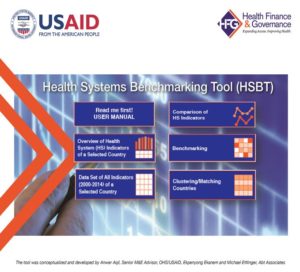USAID Launches Innovative Tool to Benchmark Health Systems
Dr. Pablos-Mendez, Assistant Administrator, Bureau of Global Health, recently launched USAID’s Health Systems Benchmarking Tool (HSBT) at an event in Crystal City. The HSBT compares low-, middle-, and upper middle-income countries on health system functions, outcomes and impact indicators.
“It is the ability to benchmark across countries, adjust variables, and produce data for planning, that transforms our ability to understand health systems,” he said.
Unlike other web-based tools, the HSBT is intended for use in the field. It can be easily downloaded and is not reliant on Wi-Fi or large bandwidth.
The HSBT includes important evidence-based information donors and health policy makers can use to compare similar countries, understand health systems strengths and weaknesses, and prioritize problems to address. The Excel-based tool includes data for 142 countries.
 “The tool tries to respond to questions of policy makers. For example, is the health system improving over time?” said Anwer Aqil, Senior Monitoring and Evaluation Advisor, Office of Health Systems, at the launch. Dr. Aqil and Dr. Ekpenyong Ekanem (HFG Project) presented the tool at the launch event.
“The tool tries to respond to questions of policy makers. For example, is the health system improving over time?” said Anwer Aqil, Senior Monitoring and Evaluation Advisor, Office of Health Systems, at the launch. Dr. Aqil and Dr. Ekpenyong Ekanem (HFG Project) presented the tool at the launch event.
The Excel-based tool focuses on the three Bureau of Global Health priority initiatives by including relevant indicators on Ending Preventable Child and Maternal Deaths (EPCMD), AIDS Free Generation, and Protecting Communities from Infectious Disease. The tool provides an option to specifically benchmark EPCMD countries using health system outcomes and impact indicators.
Development was led by the Office of Health Systems in collaboration with its Health Finance and Governance project. Karen Cavanaugh and Kathryn Panther, Director and Deputy Director, Office of Health Systems, provided leadership and support for the development of the tool.
Highlights:
- The HSBT displays data sets for 142 countries covering socio-economic, demographic and gender and health system functions, outcomes and impact indicators (2000-2014).
- It allows for comparison of indicator(s) over time by countries, countries within regions, and countries by income groups.
- It recognizes trends in health system indicators from 2000 to 2014.
- It can identify countries with best and worst health system indicators by region, income group, or by a selected group of countries.
- The data set can be imported in any statistical software for inferential analysis.
- A unique feature of the tool is its clustering function. Users can match countries’ socio-economic characteristics to control for their effects before comparing health system indicators.
Previously there were no global tools available for benchmarking health system functions, outcomes, and impact. The Health Systems Benchmarking Tool fulfills that need.
Learn more about the tool Download the tool Download the manual



